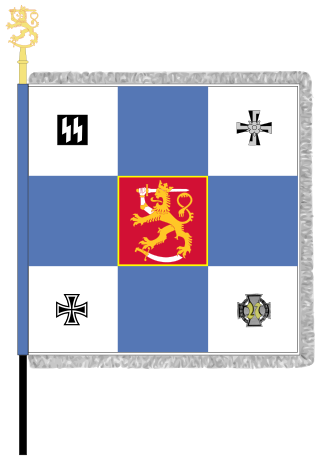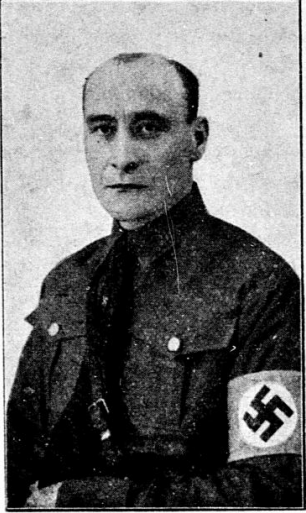Related Research Articles

The Waffen-SS was the combat branch of the Nazi Party's paramilitary Schutzstaffel (SS) organisation. Its formations included men from Nazi Germany, along with volunteers and conscripts from both German-occupied Europe and unoccupied lands. It was disbanded in May 1945.

Paavo Juho Talvela was a Finnish general of the infantry, Knight of the Mannerheim Cross and a member of the Jäger movement. He participated in the Eastern Front of World War I, the Finnish Civil War, the Finnish Kinship Wars, the Winter War and the Continuation War.

The 11th SS Volunteer Panzergrenadier Division Nordland was a Waffen-SS division primarily raised with Germans and ethnic Germans from Romania, but also foreign volunteers from Northern and Western Europe. It saw action, as part of Army Group North, in the Independent State of Croatia and on the Eastern Front during World War II.

The Order of the Lion of Finland is one of three official orders in Finland, along with the Order of the Cross of Liberty and the Order of the White Rose of Finland. The President of Finland is the Grand Master of all three orders. The orders are administered by boards consisting of a chancellor, a vice-chancellor and at least four members. The orders of the White Rose of Finland and the Lion of Finland have a joint board. The President of Finland wears the Star of the Order of the Lion of Finland.

From 1941 to 1943, 1,408 Finns volunteered for service on the Eastern Front of World War II in the Waffen-SS, in units of the SS Division Wiking. Most of these volunteers served as motorized infantry in the Finnish Volunteer Battalion of the Waffen-SS. The unit was disbanded in mid-1943 as the volunteers' two-year commitment had expired and the Finnish government was unwilling to allow more men to volunteer. In 1944-1945 a company sized unit of Finnish defectors recruited to the SS continued fighting alongside Germany.

The 20th Waffen Grenadier Division of the SS was a foreign infantry division of the Waffen-SS that served alongside but was never formally part of the Wehrmacht during World War II. According to some sources, the division was under Reichsführer-SS Heinrich Himmler's overall command but was not an integral part of the Schutzstaffel (SS). It was officially activated on 24 January 1944, and many of its soldiers had been members of the Estonian Legion and/or the 3rd Estonian SS Volunteer Brigade, which had been fighting as part of German forces since August 1942 and October 1943 respectively. Both of the preceding formations drew their personnel from German-occupied Estonia. Shortly after its official activation, widespread conscription within Estonia was announced by the German occupying authorities. The division was formed in Estonia around a cadre comprising the 3rd Estonian SS Volunteer Brigade, and was initially known as the 20th Estonian SS Volunteer Division.
Einsatzkommando Finnland was a German paramilitary unit active in northern Finland and northern Norway during World War II, while Finland was fighting against the Soviet Union with the support of Nazi Germany. The official name of the unit was Einsatzkommando der Sicherheitspolizei und des SD beim AOK Norwegen, Befehlsstelle Finnland, but it was often referred to as Einsatzkommando Finnland.

Arno Kalervo Anthoni was a Finnish lawyer who was the director of the Finnish State Police Valpo in 1941–1944. He was openly antisemite and pro-Nazi, having close relations to the German Sicherheitspolizei. Anthoni and the Minister of Interior Toivo Horelli were responsible for the deportation of 135 German refugees, including 12 Jews, Finland handed over to the Nazis in 1941–1943.

Karl Algot Jansson was a Finnish journalist and radical right-wing activist.

In Finland, the far right was strongest in 1920–1940 when the Academic Karelia Society, Lapua Movement, Patriotic People's Movement (IKL) and Vientirauha operated in the country and had hundreds of thousands of members. In addition to these dominant far-right and fascist organizations, smaller Nazi parties operated as well.
The People's Community Society was a Finnish-Swedish Nazi organization from 1940 to 1944, founded at Söderkulla Manor in the autumn of 1940 in Söderkulla, Sipoo, Finland. Admiral Hjalmar von Bonsdorff was elected its first chairman and Lieutenant Gunnar Lindqvist its secretary. Sipoo was in the 1930-1940s a center of Finnish-Swedish nazism, as in addition to Bonsdorff, another central Finnish nazi figure Thorvald Oljemark owned manor there. Unto Boman, among others, was present at the inaugural meeting, who in 1941–1944 served as a liaison to the Finnish Waffen-SS volunteer battalion in Berlin. According to him, the idea of forming a battalion was first presented at a meeting of the board of the SF. Other activists of the organization included Pehr Norrmén, an industrialist and banker who was also involved in the recruitment of SS volunteers in the spring of 1941, and Barons Bertil von Alfthan and Torsten Aminoff.
Gunnar Isak Lindqvist was a Finnish Jäger and a senior lieutenant in the Estonian Army. He had received military training during the First World War as a Jäger and received his baptism of fire on the Eastern Front at Misse River in 1916. Later, he took part in the Finnish Civil War in the White Army as a signals officer and in the Estonian War of Independence as a battalion commander. During his life he served in the armies of three states and was a veteran of the six wars. In the 1930s and 1940s, Lindqvist took part in several Nazi groups.
Lennart Reidar Armas Hedman was a Finnish educator, eugenist and far-right politician. He had a master's degree in philosophy. He had studied genetics at the University of Helsinki under Harry Federley.
Ensio Ilmari Uoti was a Finnish politician and Nazi who in the 1930s was the leader of the Finnish-Socialist Workers' Party (SSTP).
The Pro-German resistance movement in Finland was set up during the latter stages of the Second World War after the Moscow Armistice by Nazi Germany and the extreme right in Finland, who prepared for armed struggle against the expected Soviet occupation. Germany funded the activities and provided the necessary training. The project was separate from the plans drawn up by Finnish chief of staff officers in the summer of 1944 for the transition to guerrilla warfare. When there was no occupation, propaganda and smuggling hundreds of people out of Finland became the principal activity of the organization. After the defeat of Germany, the movement did not disintegrate but operated in Finland for several more years. Some members of the movement were caught, and 11 were convicted of treason in 1946.
Thoralf Kyrre was a Danish engineer who was involved in the pro-German resistance movement in Finland from 1944 to 1945.

Aarne Emil Kauhanen was a Finnish officer of the Central Detective Police (EK) and its successor, the State Police (ValPo), with special responsibility for aliens in the 1930s and 1940s. During the Continuation War, he acted as a liaison between the Finnish and Nazi German police authorities and was involved in the recruitment of the Finnish SS Battalion. Kauhanen also beat and tortured Jewish refugees during interrogations. After the war, he escaped to South America, where Kauhanen died in unclear circumstances in 1949. According to a memoir, one of his victims recognized and later shot him.
John Rosberg was a Finnish engineer and technical director of the Helsinki Telephone Association who was involved in far-right activities in the 1930s and 1940s.

Unto Ilmari Parvilahti was a Finnish photographer and businessman who served from 1941 to 1944 as the head of the liaison office of the volunteer Finnish SS battalion in Berlin. After being handed over to the Soviet Union among the so-called Leino prisoners in 1945, he spent several years there in prison camps. After returning to Finland, he wrote the memoir Beria's Gardens (1957), in which he describes Soviet prisons based on his own experiences. He was an ardent supporter of Nazism.
Kaarlo Helmer Kalas was a Finnish soldier, memoirist and spy.
References
- ↑ Kuolinilmoitus. Helsingin Sanomat, 15.4.1996, s. 6. Lehti HS Aikakoneessa (tilaajille)
- ↑ Westerlund, Lars: Itsetehostuksesta nöyryyteen – suomensaksalaiset 1933–46 (Arkistoitu – Internet Archive), p. 259–260.
- ↑ Haataja, Lauri: Kotinatsit luokkakuvassa Henrik Ekberg tutki suomalaiset johtajan varjot (Arkistoitu – Internet Archive), Helsingin Sanomat.
- ↑ Vertanen, Anu: Rintamalta Ratakadulle – Suomalaiset SS-miehet kommunistisen Valpon kohteina 1945–1948, p. 66–67. Suomen historian pro gradu-tutkielma, Jyväskylän yliopisto 2005.
- ↑ "Claes Purjo". 27 April 2022.
- ↑ Claes Purjon henkilömappi. Suojelupoliisi, Kansallisarkisto